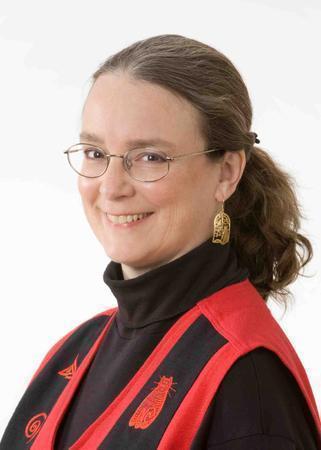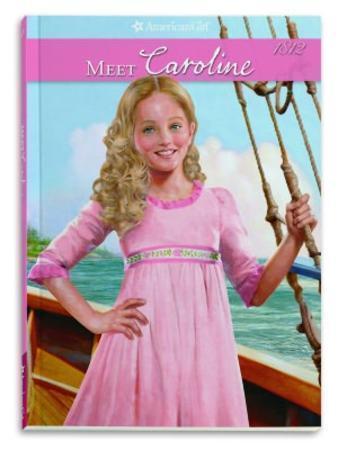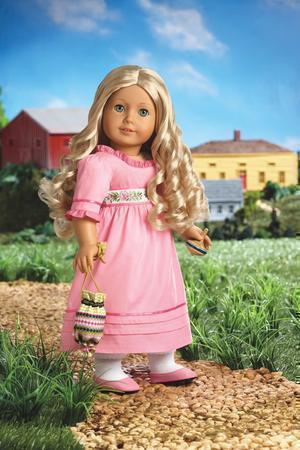 Kathleen Ernst is the author of numerous books for young readers. Most recently, she penned the Caroline Abbott books for American Girl. Below is a complete transcript of her interview with Cracking the Cover.
Kathleen Ernst is the author of numerous books for young readers. Most recently, she penned the Caroline Abbott books for American Girl. Below is a complete transcript of her interview with Cracking the Cover.
Have you always wanted to write? Why?
I was lucky enough to be raised in a house full of books. Both of my parents were voracious readers. My mom was a librarian, and whenever we planned a trip, she’d find historical fiction about that place that I could read before we traveled. We often visited historic sites such as Colonial Williamsburg, Jamestown, and Plimoth Plantation. Because of my reading, those places were alive in my imagination by the time we arrived. Obviously the combination of historical fiction and historic places made quite an impact.
In addition to inspiring my love of history, all those books I read as a child helped me realize the power of a good book. Books took me to different times and places. Whether I was happy or sad, I could find someone experiencing similar joys or sorrows among the characters I discovered. I realized that if reading books was so much fun, writing them would be even better! I wrote my first story when I was about ten, and my first novel when I was fifteen. It was never published, but I remain quite proud of it. That historical novel was my first step toward learning how to be a good writer.
Why do you write for young readers?
I love to think that my books might inspire young readers today the way authors inspired me when I was a child. Writing for kids is a privilege, and I enjoy meeting them at schools, bookstores, libraries, and festivals. I meet young people who are excited about reading and fascinated by history. Many are also accomplished writers themselves, and I do everything I can to encourage them.
How did you become involved with American Girl? What was your first exposure to it?
When American Girl released its first books about historical characters in the 1980s, I was working as a curator and educator at a large historic site called Old World Wisconsin. I began seeing girls visiting with Kirsten dolls in their arms. They had read the Kirsten series and were excited about visiting restored pioneer farmsteads. That’s the power of good writing! These girls fell in love with the character, and her fictional adventures inspired them to learn more about history.
During those early years I also sometimes fielded questions from the research department at American Girl. Perhaps someone was looking for an artifact to use as a model in one of the books. Once or twice someone called and read some small passage to me, making sure the specifics were accurate. For example, I remember a researcher once checking about the workings of oil lamps. Since I had experience using and cleaning oil lamps, I could help with the practical details. During that time I was writing historical fiction, but had not yet published any. I always ended those calls thinking how I’d love to write for American Girl one day!
I left Old World Wisconsin in the mid-nineties and moved to Middleton, WI, which by chance is where American Girl is located. My first historical novels for young readers were published (by another company) about that time. A couple of those came to the attention of an editor at American Girl just as the team there began planning a new line of independent historical mysteries. She called me and asked if I’d like to try writing one. I ended up writing three History Mysteries for American Girl, starting with Trouble at Fort La Pointe, which was nominated for an Edgar Award by the Mystery Writers of America. When that series ended, I was invited to write a mystery about Kit Kittredge, one of the core historical characters. That book, Danger at the Zoo, was followed by another Kit book and mysteries about Josefina, Kirsten, and Molly.
 How did you come to write the Caroline books? What comes first, the book or the doll?
How did you come to write the Caroline books? What comes first, the book or the doll?
I received another momentous phone call in 2009. The editorial team at American Girl had decided to do a project focused on the War of 1812, and they thought I’d be a good match. I was invited to create an 1812 character and write six books about her.
At that point, nothing else was decided. I dug into the research, and discussed setting options with my editor and the company researcher. We decided to focus on Sackets Harbor, a village on the south shore of Lake Ontario in New York. It was a vitally important region during the war, and I loved the idea of creating a complex character growing up right along the border. The exciting events that took place in Sackets Harbor during the War of 1812 provided lots of plot possibilities. I developed six story proposals, striving to create books that would work well as stand-alones, but also provide a satisfying overall story arc.
The beautiful Caroline doll is a representation of the character I created for the Caroline Abbott books. It’s been exciting to see how designers developed features from the stories to accessorize the doll. Their attention to detail is amazing.
American Girl books, dolls, etc. are extremely popular. What’s it like being the author behind one of the dolls?
It’s a huge honor! I’m passionate about history, and about writing books to help engage young readers in themes and ideas I believe are important. Working with American Girl has allowed me to do just that, and I’m grateful.
The American Girl historical characters each live during a defining time in American history. What makes the War of 1812 so important? What challenges did you face writing about this time period?
Some historians refer to the War of 1812 as “The Second War For Independence.” It’s an important milestone in United States history, proving that the young nation could defend what it earned during the Revolutionary War. Our national anthem emerged during this time as a powerful symbol of American independence.
For me, the biggest challenge was the relative scarcity of primary reference material from the era. No photographs exist, of course. I would have loved to find a young local girl’s diary from that time, but alas, I did not. But I must add that the early date provided a real “treasure hunt” feel to the process. The project researcher and I had great fun seeing what we could discover!
What was the highlight of writing the Caroline books?
May I share two? First, in terms of research, gaining a “sense of place” is important for me. It is still possible to visit Sackets Harbor and easily imagine Caroline’s life and times there—in the Sackets Harbor Battlefield State Historic Site, in the village streets, along the lakeshore. Being there was special. I also visited a number of other relevant historic sites in New York and Canada, and I toured the USS Constitution in Boston. And my husband and I took a sail on Friends Good Will, a reproduction sloop now operated by the Michigan Maritime Museum. I got to take a turn at the tiller—just as Caroline does in the opening chapter of Meet Caroline. What a thrill!
As far as actually writing the books, one of the things I’m most proud of is the presentation of three generations of strong, capable, intelligent females. Grandmother and Mama both meet difficult challenges, although in different ways . They inspire Caroline in the books to discover her own inner strength, and I hope they will inspire young readers too.
 Where does Caroline come from? Is she based on anyone in particular?
Where does Caroline come from? Is she based on anyone in particular?
One of the things that became apparent as I did research is that boys and girls in this era—especially in rural areas like Sackets Harbor—were often given extraordinary responsibilities at an early age. This gave me the freedom to create a realistic girl who is a fun-loving child, but who also must sometimes scrape up her courage and take direct action in the midst of war. I think of Caroline as a tribute to all the unnamed, unknown girls and women of the time who acted with great heroism and intelligence in the midst of war.
In a time when it seems that children are growing up faster and faster, what is it about your books and the American Girl books in general that appeal to girls?
I think the universal that connects all historical fiction with modern readers is the element of human emotion. No matter how fast children mature, they all at some time experience joy, pride, and contentment; sorrow, frustration, and fear. American Girl fans expect realistic, complex characters who experience familiar emotions—in books that provide satisfying stories and an introduction to another time and place! That’s quite a potent mix.
How is Caroline’s story relevant to today’s girls?
At the beginning of the series, readers learn than Caroline’s dearest wish is to become captain of her own ship. They also learn that Papa thinks Caroline needs to be more steady and responsible. Most girls today may not dream of becoming a ship captain, but they all have some precious goal. That creates a bond between reader and character. And in a broader sense, Caroline’s struggles and achievements can still provide inspiration for readers who are facing their own challenges—as all of us do.
American Girl is more than 25 years old. Did you feel any pressure to live up to your books’ predecessors?
I certainly hope to honor the vision of the company’s founder and first authors, who created something very special. I wanted to do my very best for the sake of the girls who will read Caroline’s stories. And I wanted to honor historical women from 1812 by creating female characters with strength and spirit.
Is there a book from your own childhood that still resonates with you today?
I loved Laura Ingalls Wilder’s books as a child, and they still have a prominent place on my bookshelf!
